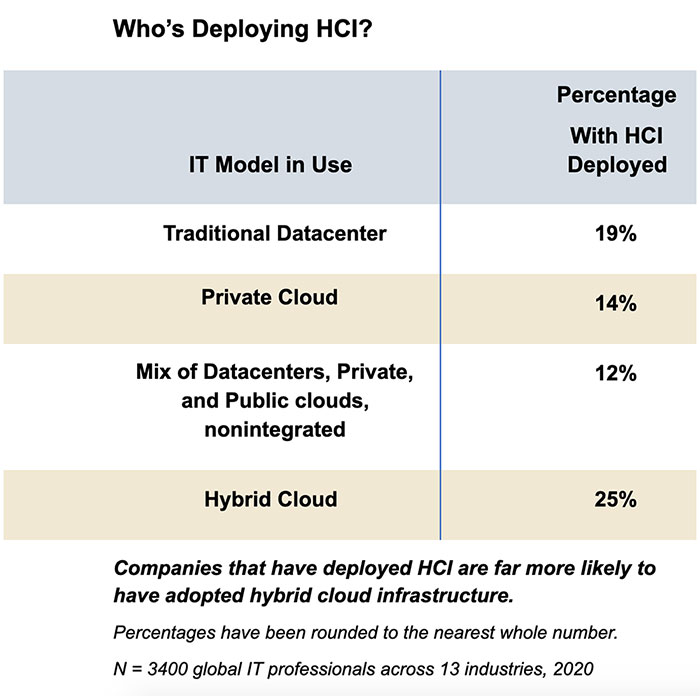Hyperconverged infrastructure (HCI) is swiftly becoming a foundational building block of modern data centers. The reasons have to do with gaining better, more dynamic control over private IT resources and costs. HCI is also positioning IT shops for smooth transitions to hybrid cloud environments, which recent global research indicates is the preferred IT operating model by most organizations worldwide.
The software-defined HCI architecture addresses businesses’ need to simplify data center operations as IT teams struggle to ensure that resources – particularly storage – keep pace with the 2.5 quintillion bytes of data reportedly generated worldwide each day. HCI also facilitates more agile data centers that can scale both quickly and cost-effectively. In a digital marketplace, having to upgrade and manage a multitiered “glass house” one specialized appliance at a time makes it nearly impossible to meet customer expectations for near-immediate service.
“We’re going through a digital transformation program, but one thing holding us back has been our three-tier data center architecture with a [storage-area network] that’s creaking at the seams,” said Dominic Maidment, technology architect at Total Gas & Power Ltd. in Redhill, Surrey, England. “It’s just too complex and difficult to manage.”
Total said it saves 95,000 British pounds a year using HCI. These are among the reasons the company embarked on a transition to an HCI foundation in March.
Strong Hybrid Cloud Foundation
Alleviating sluggish deployment times, operational overhead and capital costs aren’t the only reasons for HCI’s popularity, a market that Statista expects to grow from a $7.8 billion market in 2020 to $27.1 billion by 2025.
HCI’s attributes are also in sync with enterprise plans to expand their cloud computing environments across both on-premises and public infrastructure services into hybrid models for ultimate flexibility and control over resource usage and cost. HCI and cloud computing have characteristics in common, such as virtualization, which ease integration and compatibility issues as cloud deployments expand.
Recent research commissioned by Nutanix into global enterprise cloud investments and experiences revealed that IT organizations that had adopted HCI were further along in their transitional journeys to hybrid cloud environments than others. The Third Annual Enterprise Cloud Index (ECI) report found that a quarter of respondents running hybrid cloud today had already deployed HCI, around twice the percentage of those running some other IT models.

Calculated another way, 69% of global ECI respondents who said they were running a hybrid cloud today had deployed or were in the process of deploying HCI. By contrast, just 40% of those running a nonintegrated, mixed model of different infrastructure types had begun HCI deployments.
Total Gas & Power’s HCI project, still underway, uses both Nutanix AHV and VMware hypervisors in its branch offices and runs HCI clusters for Web apps and databases. Maidment indicated it would soon support virtual desktops in a desktop-as-a-service (DaaS) cloud consumption model that will replace its older on-prem hosted setup.
“We’re trying to bring everything into one pane of glass,” said Maidment. For example, his company has been using Nutanix Xi Beam for unified visibility into public and private cloud spending to simplify compliance, security and cost management across cloud borders.
HCI and Cloud: How Do They Differ?
HCI enables private cloud, which is one component of the hybrid private-public cloud IT model. For its part, HCI virtualizes compute, storage and network resources and combines them with software-defined management into a unified platform that hosts virtualized workloads. Multiple compute, storage, and network nodes, each created from standard server hardware, form a single cluster that IT can easily deploy, maintain and scale.
If this description is reminiscent of the virtualization capabilities widely touted about cloud computing, that’s not surprising.
“Hyperconverged systems are becoming the backbone of the [hybrid and] multicloud world,” Eric Sheppard, research vice president, infrastructure platforms and technologies at IDC, told VentureBeat magazine in March. “The value proposition of converged infrastructure solutions has evolved to align with the needs of a hybrid cloud world.”
For three years running, Enterprise Cloud Index research has shown that between 85% and 91% of global IT architects consider clouds with multiple private and public infrastructure components to be their ideal IT operating model. While compatible, HCI and cloud technology are different approaches that began life to fundamentally solve various problems. The focus of HCI initially was on simplifying and scaling IT operations for greater flexibility and cost savings.
A private or public cloud computing infrastructure, by contrast, runs physical compute, storage and network resources integrated into a single architecture. An abstraction layer pools the physical resources and delivers them as services accessible by applications and users, so the focus is more on automated self-service.
The Next Chapter
IT teams are increasingly turning to HCI as a cost-effective means to build cloud IT stacks in their private facilities and offer self-service capabilities. Private cloud technologies are evolving to securely support multi-tenancy, automate workflows and operate with platform-as-a-service (PaaS), software-as-a-service (SaaS) services and infrastructure-as-a-service (IaaS) offerings.
A new generation of HCI is emerging – informally dubbed HCI 2.0 – that extends to the public cloud. It’s likely to help HCI evolve to work the same way on-prem and in the public cloud.
“If I have uniformity across clouds, I can develop anywhere and deploy anywhere,” said Manosiz Bhattacharyya, senior vice president of engineering at Nutanix, which offers both HCI and cloud solutions.
“We’ll find the services used the most in the public cloud and provide them in the private cloud,” he said. “The pieces will be built over time.”
Joanie Wexler is a contributing writer and editor with more than 20 years’ experience covering IT and computer networking technologies.
© 2020 Nutanix, Inc. All rights reserved. For additional legal information, please go here.





